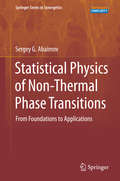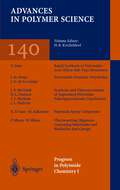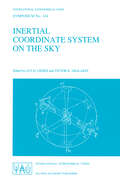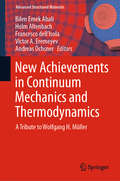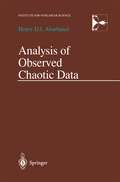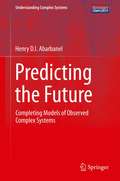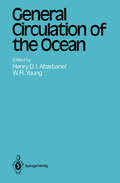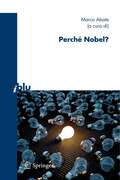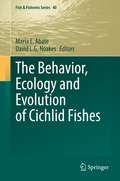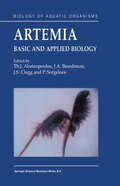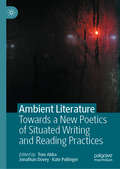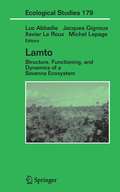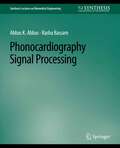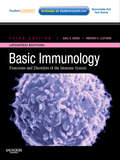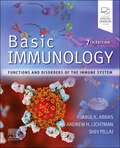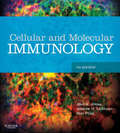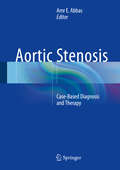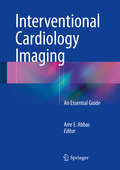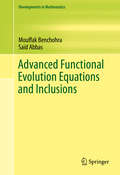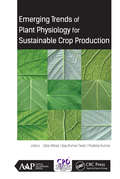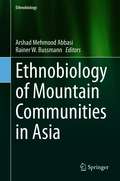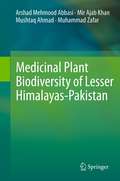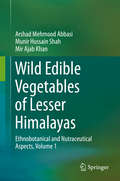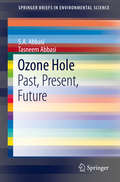- Table View
- List View
Statistical Physics of Non-Thermal Phase Transitions: From Foundations to Applications (Springer Series in Synergetics)
by Sergey G. AbaimovThis book addresses the application of methods used in statistical physics to complex systems—from simple phenomenological analogies to more complex aspects, such as correlations, fluctuation-dissipation theorem, the concept of free energy, renormalization group approach and scaling. Statistical physics contains a well-developed formalism that describes phase transitions. It is useful to apply this formalism for damage phenomena as well. Fractals, the Ising model, percolation, damage mechanics, fluctuations, free energy formalism, renormalization group, and scaling, are some of the topics covered in Statistical Physics of Phase Transitions.
Progress in Polyimide Chemistry I (Advances in Polymer Science #140)
by J. De Abajo J.G. de Campa D. L. Dunson K. O. Gaw J. L. Hedrick Y. Imai M. Kakimoto J. E. McGrath S. J. Mecham P. Mison B. SillionWith contributions by numerous exeperts
Inertial Coordinate System on the Sky: Proceedings of the 141st Symposium of the International Astronomical Union Held in Leningrad, U.S.S.R., October 17–21, 1989 (International Astronomical Union Symposia #141)
by Victor K. Abalakin J. H. LieskeIA U Symposium Number 141 "Inertial Coordinate System on the Sky" was held in Leningrad, USSR from 17-21 October 1989. The symposium also commemorated the 150th anniversary of the founding of Pulkovo Observatory. The scientific program was presented in ten half-day sessions. Most sessions were held at the Pulkovskaya Hotel, but one session which highlighted Pulkovo's current programs was held at Pulkovo Observatory. The sessions were organized into general categories pertaining to the legacy of Pulkovo for inertial systems; current programs at Pulkovo Observatory; concepts, definitions and models; and the realization and comparision of reference frames. More than 140 scientific papers were presented, either orally or in poster form. Extensive use was made of electronic mail and computer-readable communications, and more than two-thirds of the authors made use of the opportunity to submit papers for formatting by the editors. The meeting was truly a symposium in the Greek sense of the word-a free-flowing exchange of ideas and opinions. The final two papers presented at the symposium by Wilkins and by Westerhout are presented at an eady stage in the published proceedings, in order to help focus the reader's attention on the concepts and problems explored in subsequent papers. As pointed out by G.
New Achievements in Continuum Mechanics and Thermodynamics: A Tribute to Wolfgang H. Müller (Advanced Structured Materials #108)
by Bilen Emek Abali Holm Altenbach Francesco Dell'Isola Victor A. Eremeyev Andreas ÖchsnerThis book presents a liber amicorum dedicated to Wolfgang H. Müller, and highlights recent advances in Prof. Müller’s major fields of research: continuum mechanics, generalized mechanics, thermodynamics, mechanochemistry, and geomechanics. Over 50 of Prof. Müller’s friends and colleagues contributed to this book, which commemorates his 60th birthday and was published in recognition of his outstanding contributions.
Analysis of Observed Chaotic Data (Institute for Nonlinear Science)
by Henry AbarbanelA clear and systematic treatment of time series of data, regular and chaotic, found in nonlinear systems. The text leads readers from measurements of one or more variables through the steps of building models of the source as a dynamical system, classifying the source by its dynamical characteristics, and finally predicting and controlling the dynamical system. It examines methods for separating the signal of physical interest from contamination by unwanted noise, and for investigating the phase space of the chaotic signal and its properties. The emphasis throughout is on the use of modern mathematical tools for investigating chaotic behaviour to uncover properties of physical systems, requiring knowledge of dynamical systems at the advanced undergraduate level and some knowledge of Fourier transforms and other signal processing methods.
Predicting the Future: Completing Models of Observed Complex Systems (Understanding Complex Systems)
by Henry AbarbanelThrough the development of an exact path integral for use in transferring information from observations to a model of the observed system, the author provides a general framework for the discussion of model building and evaluation across disciplines. Through many illustrative examples drawn from models in neuroscience, geosciences, and nonlinear electrical circuits, the concepts are exemplified in detail. Practical numerical methods for approximate evaluations of the path integral are explored, and their use in designing experiments and determining a model’s consistency with observations is explored.
General Circulation of the Ocean (Topics in Atmospheric and Oceanic Sciences)
by Henry D. I. Abarbanel W. R. YoungThe ocean has entranced mankind for as long as we have gazed upon it, traversed it, dived into it, and studied it. It remains ever changing and seemingly never changing. Each wave that progresses through the. imme diate surf zone on every coast is strikingly different, yet the waves come again and again, as if never to end. The seasons come with essential reg ularity, and· yet each is individual-whatever did happen to that year of the normal rainfall or tidal behavior? This fascination with the currents of the ocean has always had a most immediate practical aspect: shipping, transportation, commerce, and war have depended upon our knowledge, when we had it, and floundered on our surprising ignorance more often than we wish to reflect. These important practical issues have commanded attention from commercial, academic, and military research scientists and engineers from the earliest era of organized scientific investigation. The matter of direct and insistent investigation was from the outset the behavior of ocean currents with long time scales; namely, those varying on annual or at least seasonal cycles. Planning for all the named enterprises depended, as they still do, of course, on the ability to predict with some certainty this class of phenomena. That ability, as with most physical sci ence, is predicated on a firm basis of observational fact to establish what, amorig the myriad of mathematical possibilities, is chosen by Nature as her expression of fact.
Perché Nobel? (I blu)
by Marco AbateÈ noto a tutti che i premi Nobel sono il riconoscimento più importante nel mondo in campo scientifico, letterario, economico e sociale. Molti meno ricordano invece chi abbia effettivamente vinto il premio Nobel ciascun anno; e, esclusi gli specialisti nel campo, veramente pochi conoscono il lavoro dei vincitori e sanno cosa hanno fatto di così importante da meritare l’ambito premio. Scopo di questo libro è proprio spiegare, soprattutto ai non esperti, il significato e l’importanza del lavoro dei vincitori dei Premi Nobel del 2007 (e di premi analoghi assegnati per la Matematica e per l’Informatica, rispettivamente il premio Abel e il premio Turing). Otto presentazioni agili e comprensibili, di alta divulgazione, che coprono argomenti il cui interesse e attualità è certificato dal Nobel: dai cambiamenti climatici alle cellule staminali, dalla chimica delle superfici a come funzionano gli hard disk, dai compilatori alla probabilità alla economia teorica a Doris Lessing.
The Behavior, Ecology and Evolution of Cichlid Fishes (Fish & Fisheries Series #40)
by Maria E. Abate David L. G. NoakesThis volume constitutes the most recent and most comprehensive consideration of the largest family of bony fishes, the Cichlidae. This book offers an integrated perspective of cichlid fishes ranging from conservation of threatened species to management of cichlids as invasive species themselves. Long-standing models of taxonomy and systematics are subjected to the most recent applications and interpretations of molecular evidence and multivariate analyses; and cichlid adaptive radiations at different scales are elucidated. The incredible diversity of endemic cichlid species in African lakes is revisited as possible examples of sympatric speciation and as serious cases for management in complex anthropogenic environments. Extreme hydrology and bathymetry as driver of micro-allopatric speciation is explored in the African riverine hotspot of diversity of the lower Congo River. Dramatic new molecular evidence draws attention to the complex taxonomy and systematics of Neotropical cichlids including the crater lakes of Central America. Molecular genetics, genomics, imaging tools and field study techniques assess the roles of natural, sexual and kin selection in shaping cichlid traits and beyond. The complex behavioral adaptations of cichlids are considered from a number of sub-disciplines including sensory biology, neurobiology, development, and evolutionary ecology. Most importantly, this volume puts forth a wealth of new interpretations, explanatory hypotheses and proposals for practical management and applications that will shape the future for these remarkable fishes in nature as well as their use as models for the study of biology.
Artemia: Basic and Applied Biology (Biology of Aquatic Organisms #1)
by Th. J. Abatzopoulos J. A. Beardmore J. S. Clegg P. SorgeloosThe objectives of this volume are to present an up-to-date (literature survey up to 2001) account of the biology of Artemia focusing particularly upon the major advances in knowledge and understanding achieved in the last fifteen or so years and emphasising the operational and functional linkage between the biological phenomena described and the ability of this unusual animal to thrive in extreme environments. Artemia is a genus of anostracan crustaceans, popularly known as brine shrimps. These animals are inhabitants of saline environments which are too extreme for the many species which readily predate them if opportunity offers. They are, thus, effectively inhabitants of extreme (hypersaline) habitats, but at the same time are able to tolerate physiologically large changes in salinity, ionic composition, temperature and oxygen tension. Brine shrimp are gener ally thought of as tropical and subtropical, but are also found in regions where temperatures are very low for substantial periods such as Tibet, Siberia and the Atacama desert. They have, thus, great powers of adaptation and are of interest for this capacity alone. The earliest scientific reference to brine shrimp is in 1756, when Schlosser reported their existence in the saltpans of Lymington, England. These saltpans no longer exist and brine shrimp are not found in Britain today. Later, Linnaeus named the brine shrimp Cancer salinus and later still, Leach used the name Artemia salina. The strong effect which the salinity of the medium exerts on the morphological development of Artemia is now widely recognised.
Ambient Literature: Towards a New Poetics of Situated Writing and Reading Practices
by Tom Abba Jonathan Dovey Kate PullingerThis book considers how a combination of place-based writing and location responsive technologies produce new kinds of literary experiences. Building on the work done in the Ambient Literature Project (2016–2018), this books argues that these encounters constitute new literary forms, in which the authored text lies at the heart of an embodied and mediated experience. The visual, sonic, social and historic resources of place become the elements of a live and emergent mise-en-scène. Specific techniques of narration, including hallucination, memory, history, place based writing, and drama, as well as reworking of traditional storytelling forms combine with the work of app and user experience design, interaction, software authoring, and GIS (geographical information systems) to produce ambient experiences where the user reads a textual and sonic literary space. These experiences are temporary, ambiguous, and unpredictable in their meaning but unlike the theatre, the gallery, or the cinema they take place in the everyday shared world. The book explores the potentiality of a new literary form produced by the exchange between location-aware cultural objects, writers and readers. This book, and the work it explores, lays the ground for a new poetics of situated writing and reading practices.
Lamto: Structure, Functioning, and Dynamics of a Savanna Ecosystem (Ecological Studies #179)
by Luc Abbadie Jaques Gignoux Michel Lepage Xavier RouxSynthesizing 40 years of ongoing ecological research, this book examines the structure, function, and dynamics of the Lamto humid savanna. From the history of the Lamto ecology station, to an overview of enivronmental conditions of the site, and examining the integrative view of energy and nutrient fluxes relative to the dynamics of the region's vegetation, this exacting work is as unique and treasured as Lamto itself.
Phonocardiography Signal Processing (Synthesis Lectures on Biomedical Engineering)
by Abbas K. Abbas Rasha BassamThe auscultation method is an important diagnostic indicator for hemodynamic anomalies. Heart sound classification and analysis play an important role in the auscultative diagnosis. The term phonocardiography refers to the tracing technique of heart sounds and the recording of cardiac acoustics vibration by means of a microphone-transducer. Therefore, understanding the nature and source of this signal is important to give us a tendency for developing a competent tool for further analysis and processing, in order to enhance and optimize cardiac clinical diagnostic approach. This book gives the reader an inclusive view of the main aspects in phonocardiography signal processing. Table of Contents: Introduction to Phonocardiography Signal Processing / Phonocardiography Acoustics Measurement / PCG Signal Processing Framework / Phonocardiography Wavelets Analysis / Phonocardiography Spectral Analysis / PCG Pattern Classification / Special Application of Phonocardiography / Phonocardiography Acoustic Imaging and Mapping
Basic Immunology Updated Edition E-Book: Functions and Disorders of the Immune System
by Abul K. Abbas Andrew H. LichtmanThis updated 3rd edition of Basic Immunology provides a readable and concise introduction to the workings of the human immune system, with emphasis on clinical relevance. The format makes learning easy with short, easy-to-read chapters, color tables, key point summaries, and review questions in every chapter. You’ll get the latest coverage on regulatory T cells, biology of the Th17 subset of CD4+ T cells, and more. The full-color artwork, comprehensive glossary, and clinical cases are just some of the features that reinforce and test your understanding of how the immune system functions.Covers the most up-to-date immunology information including regulatory T cells, and biology of the Th17 subset of CD4+ T cells to keep you completely current. Relates basic science to clinical disorders through clinical cases for better application in a real-world setting. Provides a full Glossary to keep you on the cutting edge of immunologic terminology. Includes appendices summarizing the features of CD Molecules, a handy Glossary, and Clinical Cases that test your understanding of how the immune system functions in health and disease. Presents beautiful full-color artwork for enhanced visual learning.
Basic Immunology E-Book: Basic Immunology E-Book
by Abul K. Abbas Andrew H. Lichtman Shiv PillaiMeticulously reviewed and updated for today's medical students, Basic Immunology, 7th Edition, is a concise text expertly written by the same distinguished author team as the best-selling, comprehensive text, Cellular and Molecular Immunology. This focused, easy-to-understand volume has been fully revised to include recent important advances in our understanding and knowledge of the immune system. A student favorite through six outstanding editions, this new edition uses full-color illustrations and clinical images, useful tables, and practical features such as Summary Point boxes, end-of-chapter review questions, glossary terms, and clinical cases—all designed to help students master this complex topic in the most efficient, effective manner possible. Emphasizes clinical aspects of immunology, including disease pathogenesis, the development of novel therapies based on basic science, and an appendix of clinical cases for real-world application. Contains new and expanded content on pandemics, COVID-19, and herd immunity; resistance and susceptibility to COVID-19; RNA vaccines and hybrid viral vaccines; tumor immunotherapy; innate immune responses to viruses; mechanisms of immunologic tolerance; and immunotherapy for autoimmune, allergic, and other inflammatory diseases, and cancer. Provides unrivalled instruction from an expert author team, all of whom are experienced teachers, course directors, and lecturers. Features a highly readable writing style and practical organization, now with fully revised content and updated images to cover new information and improve reader understanding of complex concepts. Provides additional online features such as answers to in-book chapter review questions and self-assessment questions. Presents information in a format and style that maximizes usefulness to students and teachers of medicine, allied health fields, and biology. Contains numerous features designed to help students understand key immunologic concepts: high-quality illustrations, practical tables, chapter outlines, bolded key points, and focus questions in every chapter for self-assessment and review.
Cellular and Molecular Immunology E-Book
by Abul K. Abbas Andrew H. Lichtman Shiv PillaiCellular and Molecular Immunology takes a comprehensive yet straightforward approach to the latest developments in this active and fast-changing field. Drs. Abul K. Abbas, Andrew H. Lichtman, and Shiv Pillai present sweeping updates in this new edition to cover antigen receptors and signal transduction in immune cells, mucosal and skin immunity, cytokines, leukocyte-endothelial interaction, and more. This reference is the up-to-date and readable textbook you need to master the complex subject of immunology. Recognize the clinical relevance of the immunology through discussions of the implications of immunologic science for the management of human disease. Grasp the details of experimental observations that form the basis for the science of immunology at the molecular, cellular, and whole-organism levels and draw the appropriate conclusions. Stay abreast of the latest advances in immunology and molecular biology through extensive updates that cover cytokines, innate immunity, leukocyte-endothelial interactions, signaling, costimulation, and more. Visualize immunologic processes more effectively through a completely revised art program with redrawn figures, a brighter color palette, and more 3-dimensional art. Find information more quickly and easily through a reorganized chapter structure and a more logical flow of material.
Aortic Stenosis: Case-Based Diagnosis and Therapy
by Amr E. AbbasWith the advent of less invasive treatments for aortic stenosis including percutaneous and apical replacement, more patients are being offered this technology. As such, determining the true severity of aortic stenosis is becoming paramount. Many clinical scenarios occur where the area and gradient estimates of severity do not match. This book will present case by case examples of different patients with a wide variety of aortic stenosis. It will assist cardiologists in identifying patients with true aortic stenosis who may benefit from valve replacement. It will also highlight the role and advent of new technology as the role of CTA, MRI, and 3D echo for diagnosis and TAVR and mini surgery for treatment. The audience will range from clinical cardiologists, imaging cardiologists and interventionalists alike.
Interventional Cardiology Imaging: An Essential Guide
by Amr E. AbbasInterventional cardiology has transitioned from angiographic subjective analysis of stenosis severity into assessment of plaque characteristics and objective assessment of stenosis severity. The evolution of novel interventional imaging modalities is progressively altering our understanding of coronary artery disease diagnosis and prognosis. This book will be an essential companion to assist interventional cardiologists in better assessing patients with Coronary Artery Disease. It will encompass and review all interventional imaging modalities and provide guidance for interventional cardiologists to use these modalities.
Advanced Functional Evolution Equations and Inclusions (Developments in Mathematics #39)
by Saïd Abbas Mouffak BenchohraThis book presents up-to-date results on abstract evolution equations and differential inclusions in infinite dimensional spaces. It covers equations with time delay and with impulses, and complements the existing literature in functional differential equations and inclusions. The exposition is devoted to both local and global mild solutions for some classes of functional differential evolution equations and inclusions, and other densely and non-densely defined functional differential equations and inclusions in separable Banach spaces or in Fréchet spaces. The tools used include classical fixed points theorems and the measure-of non-compactness, and each chapter concludes with a section devoted to notes and bibliographical remarks.This monograph is particularly useful for researchers and graduate students studying pure and applied mathematics, engineering, biology and all other applied sciences.
Emerging Trends of Plant Physiology for Sustainable Crop Production
by Zafar Abbas Ajay Kumar Tiwari Pradeep KumarPlant physiology is now considered as an essential ingredient for improving crop productivity, a continuing necessity with today’s ever-increasing world population. This new volume provides an understanding of the physiological basis of the various plant processes and their underlying mechanisms under fluctuating environments, which is of great importance for sustainable crop production. Further advances in cellular and molecular biology hold promise to modify physiological processes, thereby improving the quality and quantity of major food crops and ensuring stability in yield of the produce even under severe abiotic stress. This book covers the latest information on the physiological basis of plant productivity, including abiotic stress adaptation and management, plant nutrition, climate change and plant productivity, transgenic and functional genomics, and plant growth regulators and their applications. The chapters in this volume tackle some of these key issues of sustainable plant production and evolve future strategies in overcoming challenges faced by the agricultural sector as a whole. The topics covered in this book presents important from research reputed scientists. This volume is a rich source of information in one place. It will be a useful resource for researchers and extension workers involved in plant physiology and related disciplines. Key features: Provide the latest information on developments in plant physiology Covers abiotic and biotic stress on economically important crop species Presents a detailed collection of biotechnological approaches in plant physiology Covers plant growth regulators, secondary metabolites, germination, crop growth and development of different crop species Provides research from experts at internationally renowned institutes
Emerging Trends of Plant Physiology for Sustainable Crop Production
by Zafar Abbas Ajay Kumar Tiwari Pradeep KumarPlant physiology is now considered as an essential ingredient for improving crop productivity, a continuing necessity with today’s ever-increasing world population. This new volume provides an understanding of the physiological basis of the various plant processes and their underlying mechanisms under fluctuating environments, which is of great importance for sustainable crop production. Further advances in cellular and molecular biology hold promise to modify physiological processes, thereby improving the quality and quantity of major food crops and ensuring stability in yield of the produce even under severe abiotic stress. This book covers the latest information on the physiological basis of plant productivity, including abiotic stress adaptation and management, plant nutrition, climate change and plant productivity, transgenic and functional genomics, and plant growth regulators and their applications. The chapters in this volume tackle some of these key issues of sustainable plant production and evolve future strategies in overcoming challenges faced by the agricultural sector as a whole. The topics covered in this book presents important from research reputed scientists. This volume is a rich source of information in one place. It will be a useful resource for researchers and extension workers involved in plant physiology and related disciplines. Key features: Provide the latest information on developments in plant physiology Covers abiotic and biotic stress on economically important crop species Presents a detailed collection of biotechnological approaches in plant physiology Covers plant growth regulators, secondary metabolites, germination, crop growth and development of different crop species Provides research from experts at internationally renowned institutes
Ethnobiology of Mountain Communities in Asia (Ethnobiology)
by Arshad Mehmood Abbasi Rainer W. BussmannNatural resources and associated biological diversity provide the basis of livelihood for human population, particularly in the rural areas and mountain regions across the globe. Asia is home to the world's highest mountain regions including the Himalayas, Karakorum and Hindukush. These regions are renowned around the globe because of their unique beauty, climate, and biocultural diversity. Because of geoclimatic conditions, the mountains of Asia are medicinal and food plant diversity hot spots. The indigenous communities residing in the valleys of these mountains have their own culture and traditions, and have a long history of interaction with the surrounding plant diversity. Local inhabitants of these mountains areas possess significant traditional knowledge of plant species used as food, medicine, and for cultural purposes. So far, many workers have reported traditional uses of plant species from different regions of Asia including some mountain areas; however, there is not one inclusive document on the ethnobotany of mountains in Asia. This book provides a comprehensive overview on ethno-ecological knowledge and cross cultural variation in the application of plant species among various communities residing in the mountains of Asia; cross cultural variation in traditional uses of plant species by the mountain communities; high value medicinal and food plant species; and threats and conservation status of plant species and traditional knowledge. This book should be useful to researchers of biodiversity and conservation, ethnobiologists, ethnoecologists, naturalists, phytochemists, pharmacists, policy makers, and all who have a devotion to nature.
Medicinal Plant Biodiversity of Lesser Himalayas-Pakistan
by Arshad Mehmood Abbasi Mir Ajab Khan Mushtaq Ahmad Muhammad ZafarThe Himalayan region is among the largest mountains systems of the world with uncounted unique medicinal plants resources. The lesser Himalayas ranges are the extension of Greater Himalayas. They have unique ecology, vegetation and diversity of medicinal flora due to tremendous variation in the altitude, climate and associated wildlife.The utilization of medicinal plants in medicine suffers from the fact that although plants are used to treat diseases, scientific evidence is lacking in many cases. Different societies of the world use the plants according to their own beliefs and knowledge and previous experiences. Their knowledge about the use of the plants is usually not known to the other world or science. This book provides a brief introduction of Lesser Himalayas, ethnobotanical aspects, marketing and anthropogenic pressure on medicinal flora. It comprises one hundred medicinal plant species including Pteridophytes, Gymnosperms and Angiosperms (Monocots and Dicots) along with their scientific description and traditional uses.
Wild Edible Vegetables of Lesser Himalayas: Ethnobotanical and Nutraceutical Aspects, Volume 1
by Arshad Mehmood Abbasi Munir Hussain Shah Mir Ajab KhanOur intention with this book was to present the reader with the most accurate, significant, and up-to-date background and knowledge in the areas of ethnomedicinal and nutraceutical vegetation for the Lesser Himalayas in a comprehensive text. Wild Edible Vegetables of Lesser Himalayas provides a complete review of over 50 important plants of this region and details each species including photographs, botanical name, local name, family, flowering and fruiting period, status and habitat, parts used, distribution, ethnobotanical uses, cultural aspects, medicinal uses, and nutraceutical aspects. Medicinal uses include mode of preparation, method of application and diseases studied; cultural aspects and index; nutraceutical data provides analysis of fats, proteins, fibers, carbohydrates, ash, moisture content, dry matter, and energy value; elemental analysis includes various essential and toxic metals; phytochemical screening includes total phenolics, flavonoids, flavonols and ascorbic acid, and antioxidant potential in terms of DPPH scavenging activity, hydroxyl radical scavenging activity, H2O2 scavenging activity, Fe2+ chelating activity, ferric reducing antioxidant power, and phosphomolybdenum assay for each species. Wild Edible Vegetables of Lesser Himalayas is a concise and handy guide for scientists, scholars, and students interested in the study of agriculture, food science, nutraceutical science, bioscience, biodiversity, applied ethnobotany, ethnoecology, and ecology.
Ozone Hole: Past, Present, Future (SpringerBriefs in Environmental Science)
by S. A. Abbasi Tasneem AbbasiThis book underscores the re-emergence of the ozone hole problem and deals with it in its current context of exacerbating global warming. It traces the history of the ozone hole from the stage of formation of the stratospheric ozone ‘layer’, millions of years ago, into the late 20th century when the anthropogenic destruction of that ozone was discovered. The chapters are written to bring the the reader up to the present day. Factors that influence stratospheric ozone are discussed and the ways to halt ozone depletion are cataloged. And more complex interrelationships are being discovered between ozone depletion and two other global concerns: climate change and ocean acidification. This book sheds light on the intricacy of the situation and its portants.The book will be useful to students and researchers looking for a current overview of the ozone hole problem.
